Author Archive
Comics Time: Mome Vols. 14-16
November 7, 2009
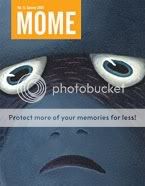

Mome
Vol. 14: Spring 2009–Kaela Graham, Adam Grano, Derek Van Gieson, Laura Park, Olivier Schrauwen, Gilber Shelton, Pic, Dash Shaw, Ray Fenwick, Ben Jones, Frank Santoro, Jon Vermilyea, Sara Edward-Corbett, Conor O’Keefe, Emile Bravo, Lilli Carre, Hernan Migoya, Juaco Vizuete, Josh Simmons, writers/artists
Vol. 15: Summer 2009–Kaela Graham, Andrice Arp, Tim Hensley, Sara Edward-Corbett, Ray Fenwick, Conor O’Keefe, T. Edward Bak, Gilbert Shelton, Pic, Nathan Neal, Noah Van Sciver, Robert Goodin, Dash Shaw, Paul Hornschemeier, Max, writers/artists
Vol. 16: Fall 2009–Kaela Graham, Archer Prewitt, Ted Stearn, Dash Shaw, Lilli Carre, Conor O’Keefe, Ben Jones, Frank Santoro, Jon Vermilyea, Nicholas Mahler, Laura Park, Nate Neal, Renee French, Sara Edward-Corbett, T. Edward Bak, writers/artists
Eric Reynolds, Gary Groth, editors
Fantagraphics, 2009
Vol. 14: 120 pages
Vols. 15-16: 112 pages each
$14.99 each
Things kinda went off the rails here, no?
Like, looking at that list of contributors, you can see some standouts: The Cold Heat material from Jones, Santoro, and Vermilyea is not the strongest Cold Heat material in the world but it’s imaginative and, particularly with Vermilyea at the drawing table, sharply delineated, as is Vermilyea’s delightfully sick solo material. Josh Simmons impresses with his blackly comic strips, particularly a memorable number involving homunculus-sized versions of Tom Cruise and Michael J. Fox grinning soullessly at the assembled paparazzi. Tim Hensley kills it as always with the concluding chapters in his Wally Gropius saga, featuring peerlessly communicated body language perhaps the greatest anti-climax in comics history. I think this is some of the tightest material we’ve seen yet from Sara Edward-Corbett–I love her white-on-black trees and her Ice Haven-esque children-adults. Lilli Carre is alarmingly good at depicting male lust. Nate Neal’s not-so-instant-karma piece in Vol. 16 is explicit and haunting. Dash Shaw is a restless talent, albeit so restless he never seems to settle down even in the middle of any given strip.
But what is Mome at this point? Gone is the “recurring cast” model. Also gone is the Saturday Night Live style approach that replaced it–recurring cast featuring a couple of breakout stars with a celebrity guest each issue. Now it’s just all over the place. Here’s Gilbert Shelton’s unfunny rock epic, here’s Ray Fenwick and Archer Prewitt and Ted Stearn’s unfunny funny-animal things, here’s an astonishingly hamfisted political comic from Emile Bravo, here’s some comics from Spain that are stiff and disjointed, here’s some Conor O’Keefe stuff that’s gorgeously McKay-ian but sort of amorphous, here’s some awkwardly self-referential stuff from Laura Park and Nicholas Mahler, here’s a T. Edward Bak cover version of Dan Simmons’ The Terror and a Renee French piece that just get buried under the accumulated other, lesser contributions. I’m not sure what Mome is supposed to deliver anymore, and I’m not sure how receptive I am to whatever it is delivering.
Two items of note
November 6, 2009* In the SPX Critics Roundtable transcript, when I wrote that Rob Clough and Chris Mautner’s last names are pronounced “Clow” and “Mowtner,” I meant that as in “rhymes with cow or Mao,” not “rhymes with glow or mow-the-lawn.” I’m gonna fix it so it’s even clearer, but I’ve heard enough excitement over people finally learning to properly pronounce those dudes’ names that I want to set the record straight.
* I have a Twitter account that you can follow: @theseantcollins.
Carnival of Sean
November 5, 2009* Just a couple of big Robot 6 posts and then I’m out for the day.
* First, I transcribed the Critics Roundtable panel from SPX. Get ready to wallow in the wisdom sprayed all over your computer monitor or iPod Touch screen by Rob Clough, Gary Groth, Bill Kartalopolous, Chris Mautner, Joe McCulloch, Tucker Stone, Douglas Wolk, and yours truly.
* And here’s an alarmingly comprehensive round-up of the past week’s Con War/Wizard/Gareb Shamus developments. You’re really gonna wanna follow the links on this one. Hours of entertainment.
Comics Time: Captain America: Reborn #4
November 4, 2009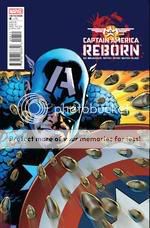
Captain America: Reborn #4
Ed Brubaker, writer
Bryan Hitch, artist
Marvel, November 2009
40 pages
$3.99
In which we learn that Sharon Carter is not just the Billy Pilgriming Captain America’s “constant” in the Lost sense–she’s literally a Cap magnet, pulling him toward her through the timestream thanks to some nanotech in her blood. Ain’t Marvel Universe pseudoscience grand? That’s really all I need to get me over what reservations I had about injecting a time-displacement angle into Brubaker’s years-long top-drawer super-spy saga. And to be fair, the megastoryline kicked off with the Cosmic Cube, the wonkiest of all Marvel’s made-up tech/mystic mumbo jumbo, while one of its best scenes to date involved Bucky’s dismembered cybernetic arm springing to life and taking out a room full of SHIELD goons, so this is not without precedent. (There were some cool giant robots in there too, iirc.)
One of my favorite things about Brubaker’s run–and in this he’s been indispensably assisted by a solid stable of artists, led by Steve Epting and Mike Perkins and stood in for here by the slicker style and cantilevered action of Bryan Hitch, who in every other way is consistent with the established tone–is just how good he is at grouping various super-people together and having those groupings make visual and practical sense. Several times I’ve touted how he’s established this sort of underbelly to the Marvel Universe involving super-powered espionage-based characters: Steve Rogers, Bucky, Black Widow, Union Jack, Crossbones, Agent 13, Nick Fury and so on all look like people you really could believe take advantage of whatever relatively slight super powers they have, put on some form-fitting garb and skullcaps, and go out and assault people in classified military installations. In this issue you see some new combos in that regard, most notably a Bucky-Cap/Black Widow/Ronin trio, who are put through the paces by Hitch in a memorable hit-and-run attack in Marvel’s oft-destroyed Times Square. Elsewhere, Bru and Hitch take a trio of gaudier, more straightforwardly superheroic characters–Mister Fantastic, Hank Pym or whatever he’s calling himself now, and the Vision–and, despite this being the least naturally resonant area of the Marvel U. for Brubaker’s Cap, somehow make them click in that world as a braintrust tasked with cracking the enemy technology that’s brought Cap low.
But the best such scene–the scene that made me want to write the book in the first place–occurs when Homeland Security Commissar Norman “The Green Goblin” Osborn’s right-hand woman Victoria Hand (yup!) drags Sharon Carter, the brainwashed and disgraced Agent 13, in handcuffs into a secret lair. She looks down, and there looking back at her are Doctor Doom, the Red Skull (who’s now trapped in a robot body with a Red Skull mask and an SS uniform), racist luchadore Crossbones, Skull’s S&M daughter Sin, and the torso-themed robot Nazi mad scientist Doctor Arnim Zola. Sharon’s reaction is more bugged-out disbelief than anything else, and it’s entirely appropriate: As assembled by Brubaker, drawn by Hitch, and staged in a clever two-level set-up by the two of them, man oh man does this come across as a batshit-insane crew of lunatics. You really can’t even begin to imagine what kind of crazy horrorshow they’ve got in store for whoever’s unlucky to be dragged into that lab; it’s like the scene in Blue Velvet where Dennis Hopper forces Kyle MacLachlan into Dean Stockwell’s place, only with Doombots and time machines instead of overweight prostitutes and Roy Orbison songs.
And now that I’m writing about it, the scene reminds me in its weird, you-gotta-be-shitting-me way of a very different “here come the bad guys” reveal: that wonderful spread in the first issue of Geoff Johns and Phil Jimenez’s Infinite Crisis where you realize that Uncle Sam and the Freedom Fighters are about to get their collective bell rung by Bizarro, Zoom, Cheetah, Sinestro, Black Adam, Deathstroke, Dr. Light, Psycho-Pirate, and that DC Magneto guy Dr. Polaris–just about as fearsome an array of opposite-numbers and cool power-sets as DC can offer. But while that was prime momentism, this is like anti-momentism–the staging peels back the “whoa” factor and transforms it into a sort of wordless shudder. This is the kind of thing you want every superhero comic you read to be able to deliver.
Carnival of souls
November 4, 2009* A pair of heavy-hitters in the Strange Tales Spotlight today, in honor of the third and final issue’s release: Paul Hornschemeier and Jeffrey Brown.
* Josh Simmons has changed my mind: Now I want someone to pay him six figures to adapt Stephen King’s It. (Sorry, Al–you snooze, you lose!)
* Wow, this Steven Grant essay about how we’ve entered the Disco Age of comics (meant pejoratively) is just super-duper wrong about both disco then and comics now. And frustratingly, he tosses in a bit about how people who weren’t around in the late ’70s don’t understand disco, so now I can’t explain why it’s wrong because I wasn’t around then and therefore don’t understand. Curses, foiled again!
* Tom Spurgeon really sinks his teeth into Darwyn Cooke’s Richard Stark’s Parker: The Hunter. It is so good to have Tom reviewing again!
* I’m a few days late on this, but Matt Zoller Seitz’s video essay “Unreal Estate,” a compilation of establishing shots of various buildings where bad things end up happening in horror movies and other films, is his best video essay yet. I even did pretty good at ID’ing the films. Barton Fink was a very welcome inclusion.
* Speaking of both Seitz and scares, he’s a contributor to IFC’s fine list of the 25 Scariest Moments in Non-Horror Movies. Chances are that if it just sprung into your mind, it’s on the list. Seitz’s highest-ranking write-up happens to be the only act of violence in a film that made me cry.
* Jim Woodring updates us on his next two (!) Frank projects.
* The Weinsteins are really, seriously, they-mean-it gonna remake Hellraiser. They don’t know with whom, other than executive producer Clive Barker, but they’re gonna do it by god.
* Finally, rest in peace, San Diego Comic-Con founder Shel Dorf.
Gossip Girl thoughts
November 4, 2009* My favorite line of the night actually came from the “previously on Gossip Girl” thing at the beginning of the episode, when Olivia said to Dan, “I lied because I care about you.” That’s Gossip Girl in a nutshell, this season more than ever. It should be tattooed on every character’s forehead.
* Actually, my real favorite line of the night wasn’t on the TV at all. It comes from The Missus, who when Dan and Olivia were snuggling in bed turned to me and asked “Do you think Dan’s morning breath has integrity?” You bet it does, honey.
* “Van der Bilt”? Uh, okay. Van der Woodsen too. Van der Bass? Van der Waldorf?
* I liked the line about a Rasmussen poll having a Democrat in the lead. This really is a fantasy world!
* I enjoyed the lame actor character. More people need to answer doors and attend parties in their boxer briefs.
* The funniest bit of the night is Blair telling Serena about “my best friend Brandeis,” whom she met that afternoon–perhaps the most literally childish thing Blair’s done in a season full of Blair doing childish things. Please tell me I wasn’t the only person who immediately thought of Eric Wareheim’s new best friend Raz and Tim Heidecker’s new best friend Tony…
Hey, who needs the hoes, right, Blair?
* I love that Blair was so mean to Serena, because the meanness was accurate. Serena is a slutty lush!
* Jimmy Fallon. Jesus Christ.
* Jenny looks cute with no make-up. She should get sick more often.
* I spent a long time baffled as to whether or not Nate actually did stage the drowning. I didn’t know what the hell was going on until we got some seemingly superfluous shots of Trip’s missus.
* Speaking of, how wonderful was her mustache-twirling exchange with Grandfather? Her: “This couldn’t have worked any better if it was planned.” Him: “You!” I like a good “you!”
Carnival of souls
November 3, 2009* Lots of Benjamin Marra news today: He’s officially launched his renamed Traditional Comics publishing outfit’s new website and blog, done a new Super Satan comic for Vice, and gotten hisself interviewed by Vice’s Nick Gazin. Said interview containes such awesome statements as the following:
I think that Space Beaver comic has served as a template as far as the kind of comics I’d like to create.
…
Muscles are cool. They represent power and strength, which are cool qualities.
…
I’d like to see superhero comics return to the male power fantasy. And that just makes me think of having muscles that would allow me to decimate any adversary.
Indeed. Indeed.
* Hey, check out this unofficial teaser image for Brendan McCarthy’s upcoming Spider-Man/Doctor Strange: Fever. (Via Robot 6.) I’ll be over here, patting myself on the back.
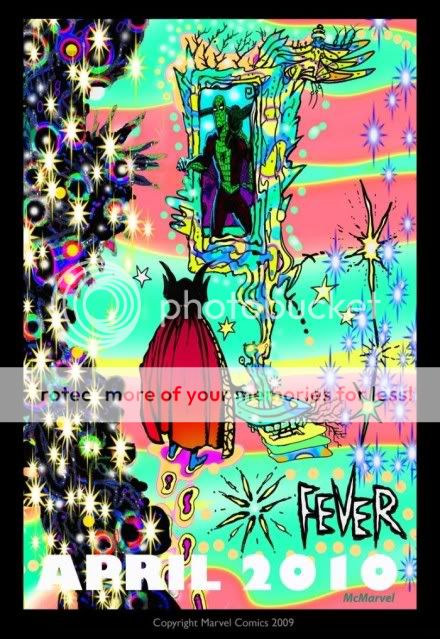
* Jon Hastings is helping me work through some lingering questions I had about the relationship dynamic in Paranormal Activity in the comments for my review of that film. I think he’s pretty much spot-on with everything he’s saying.
* I’m not going to spoil it by posting the image because you really need to see them side by side, but Ilkka Sarpola’s cover version of the cover for Frank Miller’s Sin City: A Dame to Kill For at the Covered blog is my favorite Covered cover version yet. You instantly picture a vastly more believable and disturbing story in your head looking at this thing.
* Spurge is right: By all means, go, look at the comics of Marguax Motin.
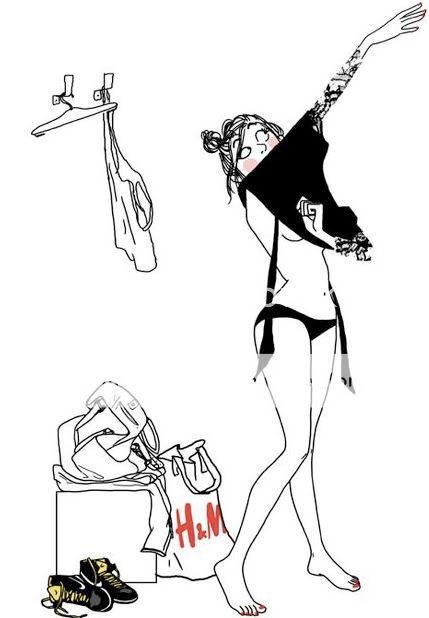
* Dirk is right: By all means, go, look at the pin-ups of Fernando Vicente.

* This sort of forward-thinking initiative is why Bloomberg’s gonna win in a walk today.
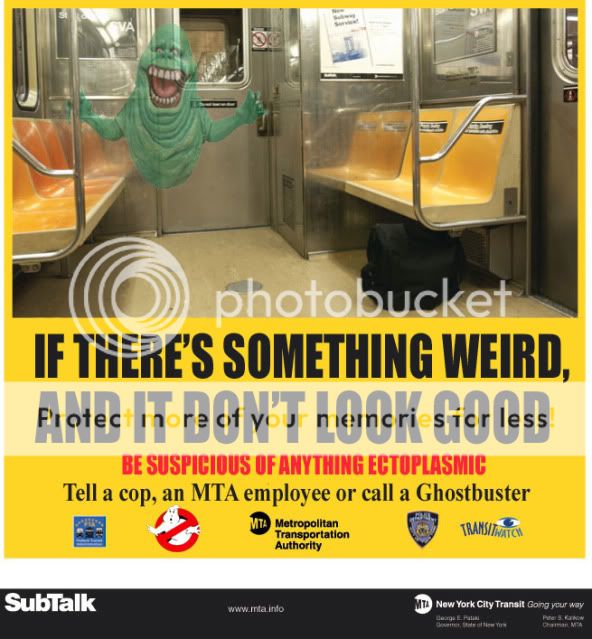
* Tim Hodler takes slacker linkbloggers to school.
* Ezra Klein takes priggish luddite fuddy-duddy know-it-alls to school.
* Finally, Jesus.
Thought of the day
November 3, 2009I want someone to pay Al Columbia six figures to adapt Stephen King’s It.
Lost in Zombieland
November 3, 2009Look: I get it. It’s a horror comedy. True, the non-horror comedy parts were a bit shopworn. Of course the neurotic guy’s phobias include clowns, and when a zombie clown finally appears, of course he says “Look at this fucking clown.” Of course the redneck carries a banjo he uses as a weapon, and when he uses it to lure out zombies, of course he plays “Dueling Banjos” on it. And of course the junk food he’s obsessed with is fucking Twinkies.
But the horror-comedy aspects were pretty top drawer. I’m sort of astonished by the credit sequence, for example. A series of shockingly gory kills, played for laughs, shot in super slow-mo so they look like a cross between one of those stagey horror photos by Whatsisname and that Spike Jonze video with the burning guy chasing the bus (referenced outright, by the way), and soundtracked by the ever-awesome “For Whom the Bell Tolls”? Add in the slightly overripe, saturated color palette that medium-budget studio efforts all seem to use these days, and the whole opening plays like an Opposite Sketches version of Zack Snyder’s Dawn of the Dead. Hey, well played!
The four main characters, they’re okay. Jesse Eisenberg must feel about Michael Cera the way Gollum feels about the Ring–he hates and loves him, as he hates and loves himself–but he’s pretty game in this the second film in which he’s a one-man Cera cover band who has some adventures in an amusement park. Woody Harrelson’s genial shitkicker is woefully underbaked, a collection of pro forma cliches that coasts entirely on Harrelson’s CV full of genial shitkickers, but that meant I could pretend this was an unofficial sequel to Natural Born Killers, which was a ton of fun. It’s entirely plausible that Harrelson played this role while all the while thinking of himself as an older, slightly mellower, but no less lethal Mickey Knox. Abigail Breslin is spunky and seems to be aging into teen roles pretty gracefully, while the other girl they gave the raccoon-eye make-up to was fine in a cute tough girl with a soft streak kinda way. Mostly I like dark-haired girls in jeans and t-shirts with rock and roll make-up, so, you know, mission accomplished there.
And the movie had its moments. I liked the fourth-wall-busting use of Columbus’s “rules,” popping up and getting knocked around by the action. Riffs a little bit on Tarantino, presages what I’m assuming will happen in Edgar Wright’s Scott Pilgrim movie, which you can’t help but think about when you’re watching a post-Shaun of the Dead zombie comedy starring a guy who’d play the other Michael Cera character if they did a new version of The Twelfth Night. Great bit with the girl from the next apartment. Some nice music on the soundtrack, “Oh Sweet Nothing,” “Kingdom of Rust,” ” Everybody Wants Some.” And though it was thoroughly spoiled for me by now, great cameo.
But then! They fucking kill the guy, act like it’s no more big a deal than if they broke his television, crack jokes during his death, dump his body off his balcony, and carry on having target practice and goofing around and doing the romantic-comedy bit as though nothing had happened. FUCK that. I seriously almost walked out. Not because I was so ouuuuuutraaaaaaged or anything, but because how the fuck could I care about anything else that happened? Like I said, I get it: It’s a horror comedy. But it’s a horror comedy predicated on the notion that these four people grow to care about each other and act accordingly–I mean, you could see that ending coming a mile away. (Though its wonky timeline was a surprise.) And yet they run into another living person, a person that for reasons I won’t spoil they already feel enormously attached to, a person who’s being really, really nice to them–and, might I add, a person who was in a far better and more tonally consistent horror comedy!!! And then they fucking kill him and act like they don’t care? Blam, there goes the whole movie. I was thrown so far out of it it was like someone hit the eject button. I didn’t care about Tallahassee’s tragic backstory anymore, I sure as shit didn’t care about the romance, I didn’t care about the pointless “big climactic battle” at the amusement park. Totally, utterly movie-ruining misstep. To paraphrase the movie itself, “[NAME REDACTED] was a photo in someone’s wallet, too.”
Carnival of souls
November 2, 2009* The theme for today at Robot 6 was people interpreting other people’s work. Besides this impressive sneak peek at an upcoming theatrical adaptation of Phoebe Gloeckner’s The Diary of a Teenage Girl…
…there’s also Tony Millionaire doing Achewood, Ryan Dunlavey & ToyFare’s excellent comic-strip mash-ups, and Dustin Harbin’s Dune book club–featuring art by Paul Pope, Dustin, and lots of other folks.
* Speaking of Paul, I love his dirty drawings.
* Tom Spurgeon reviews The Best American Comics 2009. Heck, Tom Spurgeon reviews a comic!
* Curt Purcell gives Blackest Night its midterm progress report. He’s not that impressed. That’s fine. What’s irking me (and Curt’s not guilty of this so much as the reviewers he links to, who fall all over themselves to find inventive new put-downs) is the fashionable new response to Johns’s work among many comics critics, which is that he likes Hal Jordan too much and therefore he stinks. I’m sorry but the idea that he likes Hal Jordan more than, say, Grant Morrison likes Bruce Wayne or Kal-El is ludicrous.
* Keep posting Cold Heat stuff on your blog and I’ll keep linking, Frank Santoro.
* Jeet Heer discusses what he thinks The Comics Journal has done well lately, and by implication what it’s done not-so-well. I think they’re simply at the mercy of whoever wants to do reviews and criticism for that publication anymore. I love that they’ll pay me to talk to Josh Cotter for an hour, but I’d rather read something and post a review of it that same day than read something that’s a few months old and watch the review come out a few months after that. I’ll be curious to see if the new site gets involved in the day-to-day discussion again.
* My wife is pretty. And pale.
Comics Time: Pim & Francie
November 2, 2009
Pim & Francie: The Golden Bear Days
Al Columbia, writer/artist
Fantagraphics, 2009
240 pages, hardcover
$28.99
At SPX this year, a friend of mine approached Al Columbia for a sketch in his themed sketchbook. Columbia started drawing, didn’t like it, tore out the page, crumpled it up. Started drawing again, didn’t like that one either, tore out the page, crumpled it up. Told my friend he couldn’t do it with all the noise and distractions in the room. Stopped drawing sketches for anyone for the rest of the day, except for a tiny circle-dot-dot-curve smiley face next to his signature for anyone who purchased a copy of this book. After I heard this story I told it to a couple of friends. One remarked that if he’d been forced to concoct a story about what trying to get a sketch from Al Columbia would be like, this would have been it. Another said he’d agree with that assessment, but only if Columbia had been paid for the work first.
Al Columbia may be the closest alternative comics has come to producing a Syd Barrett, an Axl Rose, a Sly Stone, a Kevin Shields, a sandbox-era Brian Wilson, or heck, a Steve Ditko–a prodigious, world-beating talent chased off stage by his own…ugh, I don’t want to say demons, but even if you ascribe Columbia’s Big Numbers flameout and lack of published work post-Biologic Show to perfectionism, surely perfectionism that total and unforgiving is a demon of a kind.
The genius of Pim & Francie is harnessing the power of that demon–whatever it is or was that led Columbia to abandon his impossibly immaculate conceptions of monstrousness and murder half-drawn on the page time and time again–and deploying it as a conscious aesthetic decision. Reproducing unfinished roughs, penciled-in and scribbled-out dialogue, half-inked panels, torn-up and taped-together pages, even cropping what look like finished comics so that you can’t see the whole thing, Columbia and his partners in the production of this book, Paul Baresh and Adam Grano, have produced a fractured masterpiece, a glimpse of the forbidden, an objet d’art noir. As I wrote on Robot 6 the other day:
my favorite thing about Columbia’s comics–many of which can now be found in his new Fantagraphics hardcover Pim and Francie–is how they look like the product of some doomed and demented animation studio. It’s as though a team of expert craftsmen became trapped in their office sometime during the Depression and were forgotten about for decades, reduced to inbreeding, feeding on their own dead, and making human sacrifices to the mimeograph machine, and when the authorities finally stumbled across their charnel-house lair, this stuff is what they were working on in the darkness.
The horror of Columbia’s sickly-cute Pim & Francie vignettes–a zombie story, a serial-killer story, a witch-in-the-woods story, a haunted-forest story, a trio of chase sequences–is extraordinarily effective. And the stand-alone images both inside and outside those stories–the Beast of the Apocalypse as story-book fawn, a field of horrid man-things staring right at you, a broken-down theme park and the phrase “there’s something wrong with grandpa,” a forest of crying trees, some dreadful being of black flame running full-tilt down the basement stairs, zombie Grandma stopping her dishwashing and glancing up toward where the children sleep–are as close as comics have come (hate to keep using that formulation, but there you have it) to the girls at the end of the hall in The Shining, the chalk-white face of the demon flashing at us in Father Karras’s dream in The Exorcist, the inscrutable motionlessness of characters in The Blair Witch Project and Paranormal Activity. The craft involved in their creation is simply remarkable, with Columbia’s assuredness of line, faux-vintage aesthetic, and near-peerless use of blacks all actually gaining from his panels’ frequent extreme-close-up enlargement throughout the collection.
But moreover, these scary stories and disturbing images are all so gorgeously awful that they appear to have corrupted the book itself. They look like they’ve emerged from the ether, seared or stained themselves partly onto the pages, then burned out, or been extinguished when the nominal author shut his sketchbook and hurled it across the room or tore up the pages in terror. It’s comic book as Samara’s video from The Ring, Lemarchand’s box from Hellraiser, Abdul Alhazred’s Necronomicon from Lovecraft, the titular toy from Stephen King’s “The Monkey”–an inherently horrific object. Bravo.
The stand
November 2, 2009In the long list of things that Nigel Tufnel was right about, “there’s a fine line between stupid and clever” is right up near the top. Which side of that line Paranormal Activity falls on has been bedeviling me since I (finally) saw it Halloween afternoon. Just by way of a for instance, while we chatted about the film in the lobby, I complained to the folks I saw it with about the demonologist who never barked. If the filmmakers were never going to actually put him in the movie, why introduce the concept in the first place? It left me with this weird sensation that either a chunk of the movie had gone missing, or the filmmakers just didn’t have that much of a grasp on what they were doing. But then my wife theorized that maybe that truncated feeling was the point–the movie gets you believing that this demonologist will show up “in a few days,” so when the end comes and he’s still nowhere in sight, it’s all the more shocking. Which got me to thinking about how I’d spent most of the movie believing the climax would come on the night of October 31st, only for the proceedings to stop short several weeks before then. Then there was my brother’s paranormal-buff fiancee, who “explained” that this kind of haunting had to be “a demonic” rather than the work of a (formerly) human entity, so they needed to address this (the psychic telling them to hire a demonologist) without actually allowing it to fix the problem (Micah puts off calling him, and when Katie finally does, he’s out of town). You could probably go back and forth about all the other loose ends–the house fire, Katie’s sister, the haunting of Diane back in the ’60s–in a similar fashion.
Ditto the believability of the two main characters. I found Micah’s desire to get to the bottom of the haunting rather than wave the white flag, even when this ran counter to Katie’s express wishes, a totally credible trait; amusingly, my wife found his behavior so dickish as to shatter her suspension of disbelief. On the flip side, I thought the seams really showed on Katie’s performance during scenes where she was obviously required to express a certain sentiment or say a certain line; The Missus found her compelling and her story sad. That part we agree on, at least, which is why this post analogizing the story arc of Paranormal Activity to domestic violence has lodged itself in my head the way it has. Overall, again, it’s difficult to say whether the shortcomings of the characters are simply the fault of them as characters or the result of poor choices by the filmmakers.
And the scares? As I alluded to the other day, the film shares with The Hurt Locker a structural advantage: The second you’re placed in a certain environment (a mission/bedtime), you in the audience are prepped to have the shit scared out of you (by an explosion/by the haunting). Both films smartly let you do most of the work for them, letting you sit there, hearing the pounding of the blood in your ears, straining toward the screen to see what happens yet pushing back in your chair dreading it as well. Paranormal has the added advantage of doing for bedrooms what Psycho did for showers and Jaws did for beaches, transforming a familiar environment into a locus of horror–how much of the “scariest movie ever” buzz simply stems from people not being able to avoid their own bedrooms and therefore recalling the movie whether they want to or not? Ditto how deftly it works with the uncomfortable idea of being watched while you sleep–by a camera, by some malevolent entity, and (we’ll get to this again later) even by someone you love.
The difference between the two set-ups, of course, is that Kathryn Bigelow pretty much delivers something memorable every time, from world-class action sequences to gorgeous scenery to those haunting extreme close-ups of falling shells or shockwaves. Director Oren Peli, on the other hand, can really only show you a static shot of a bedroom or a shakicam shot of a living room, in night vision; at times, the “action” disappears into the darkness where you’re vaguely aware there’s something going on–the tug of war between Micah and the demon after it drags Katie out of bed is the best example–but can’t make it out. Once again, is this a deft use of parametric filmmaking or amateur hour?
With all these unsettled questions, there’d be no way I’d feel comfortable proclaiming this “the scariest movie ever made” even if I were inclined in that direction to begin with. Which (the moment you’ve been waiting for!) I’m not. With a couple of exceptions, there was nothing here you couldn’t get out of a particularly well done episode of A Haunting; in fact I can think of a moment from that series that scared me and The Missus worse than anything here. Because of the film’s abrupt ending, the sense of relentless pacing and crescendoing terror that characterizes (here it comes) The Blair Witch Project is absent. With it goes the gut-wrenching grinding down of the protagonists–Katie can collapse and cry on the floor all she wants, there’s still nothing here that approaches that desperate conversation between Heather and Mike as they droolingly rattle off their favorite foods, knowing they’ll probably never taste them again. There’s no sense that Micah and Katie have been driven to that desperate a strait, even after the thing yanks her out of bed and bites her.
A big part of the problem is that just like Micah (and Katie, prior to her final under-the-influence decision to stay), we in the audience can’t help but associate the haunting with the house. That’s what a million haunted-house movies and stories have taught us to do since time immemorial. Even ones that aren’t predicated on the location still tend to make tremendous use of it–cf. The Exorcist and how inseparable your memories of it are from that freezing cold, harshly illuminated bedroom. Paranormal Activity is similar: It does such a good job of violating domestic tranquility and transforming the bedroom, a place of comfort and refuge, into a horrorshow, that you can’t help but want to scream at them “Check into a hotel and hang out in the lobby overnight! Go to a Walgreen’s!” As hard as the movie works to establish that there’s no escape, it also never shows them trying and failing to do so (budget limitations, perhaps?), so we’re left wondering what-if and letting the air out of the scare. Heather, Josh, and Mike are lost in the woods; Micah and Katie could go grocery shopping or visit his mom or catch a flight to Hawaii if they wanted.
But all of this just keeps the movie from being an awesome stone-cold classic. I think it’s still a fine film, and largely for the same reasons it’s not a great one. All that ambiguity about the characters, the loose plot threads, whether or not they could have escaped–that’s still very interesting, even if you can’t nail it all down as a point in the film’s favor for certain. I find myself thinking “What if he’d done this? What if she’d tried that?” It’s giving me something to chew on.
And while nothing here genuinely freaked me out once I was in the comfort of my own home–something Blair Witch, The Exorcist, The Shining, and The Ring all managed to pull off, just to name a few–nor really traumatized me during the viewing–all those movies, The Texas Chain Saw Massacre, The Birds, Psycho, Hostel, The Descent, Hellraiser, Hellbound, etc etc–I can say that there were a few world-class horror images in here. Not the grunts and footprings, not the mysterious photograph, not the ouija board, not the shattered photograph, at least not for me. What got me were two things. For some reason, the lights being flipped on and off really got me. They weren’t flickering–something was walking around turning lights on and off. Not only was something else present in the house, it was basically using the house the way we would–only it was nothing like us in nature or intent. I dunno, that creeped me out pretty bad.
But best/worst of all were the two scenes where somnambulist Katie got out of bed, turned to face it, and just…stood there, for hours and hours. That’s pure automaton Freudian uncanny, of course, and a monumental horror-image par excellence. And it’s reminiscent of the original-edit ending of Blair Witch to boot–to this day the scariest thing I’ve ever seen in a movie–because there’s just no reason for it to be happening. It hits all my buttons, hard, as does the resolution of that first scene, where she walks away and Micah finally wakes up, following her down and out into the backyard, where she’s just swinging in a swing. These are actions that really have no inherent emotional or psychological content whatsoever. They’re purely neutral. But when you have no idea why someone’s doing them, even totally neutral actions can become sinister, almost intolerable. That much I’m sure about.
More to come, but for now
October 31, 2009Paranormal Activity and The Hurt Locker have a lot in common.
Happy Halloween from all of us at Marvel Super Heroes: What The–?!
October 31, 2009holy moley my words are coming out of stan lee’s mouth
Not Comics Time: Portable Grindhouse: The Lost Art of the VHS Box
October 30, 2009
Portable Grindhouse: The Lost Art of the VHS Box
Jacques Boyreau, editor
Fantagraphics, 2009
200 pages, slipcover
$19.99
Buy it from Fantagraphics, eventually
Buy it from Amazon.com eventually too
My entire circle of friends has been clamoring for this long-delayed collection of video box art for over a year–and could this be any more in my wheelhouse right now? If you made a Venn diagram out of the New Action, the Manly Movie Mamajama, and everything I talk about it that Dark Knight Strikes Again review, you’d find this right in the sweet spot. Even if this book didn’t exist, it would be necessary for me to invent it.
So let’s start by talking about what I didn’t like about it. Well, “didn’t like” is probably too strong–it’s fine, just not what I was looking for–but I couldn’t help but be let down by editor and compiler Jacques Boyreau’s introduction. You get a brief sketch of his personal history with home video, a lengthy technical history of the format, and a diatribe about the evils of digital. Actual discussion of “the lost art of the VHS box” is reserved for an interesting but meager two-paragraph rumination on the way their display in video stores made them the iconic equivalent of the films they contained, but this quickly gives way to one last swipe at DVDs, downloads, and digital projection. Nothing about any of the artists or designers involved, nothing about the evolving aesthetics of box art as home video went became a megabusiness, nothing about any of the covers on the pages that follow. If you’re looking for information about the business and creative decisions that led to the creation of this childhood-memory art form, you’ll come away disappointed.
But if you’re simply looking for a gallery of those memories and beyond, Boyreau did you right. He and designer Jacob Covery wisely chose to present the front cover of every box in the context of a product shot, rather than simply scanning the art and running it full-bleed–he’s absolutely right to argue that these images are inseparable from their status as objects. The box shots of the front cover (and spine) occupy the right-hand side of every spread, while the left-hand side reproduces the back cover. And here they do scan it and run it full-bleed, which actually just makes it funnier. Why? Well, it was clear from the start that what you needed to do with the front of your VHS box was make the image as lurid and eye-catching as possible, so there are surprisingly few variations in that regard beyond obvious budget and talent limitations in some cases. But what to do with the back cover? For a long time, no one seemed to know. The familiar tagline/teaser blurb/stills/credits framework was far from universal, and in its place were long lists of other movies released on home video by the studio (on the back of Vanishing Point, Magnetic Video Corporation listed fully fifty-eight), terse flat-affect plot summaries (The Chamber of Fear‘s blurb begins “The crevice of the volcano is very deep. Scientists are searching for a form of underground life that according to theory still exists.”), poorly written catalogues of the depraved behavior contained inside (Blood Spattered Bride notes “Although not rated this film contains nudity and scenes of graphic violence”), and in one memorable case (The Best of Burlesque–somehow I doubt it!) just a flipped and blown-up segment of the front cover’s airbrushed T&A illustration. Seeing all this proto-professional weirdness on the page normally reserved for placing the image next to it in some sort of factual context is hilarious.
But let’s face it, you’re here for the front covers, and they don’t disappoint. You’ve got titles like Drive-In Massacre, Don’t Go In the House, and Slave Girls from Beyond Infinity. You’ve got taglines like Video Violence‘s “…When renting is not enough!!”, Slashdance‘s “SAVE THE LAST DANCE…FOR HELL!” and The Lift‘s “TAKE THE STAIRS, TAKE THE STAIRS. FOR GOD’S SAKE TAKE THE STAIRS!!!” You’ve got images you likely remember from the scary sections of your local mom-and-pop video shop–the girl-gun of Master Blaster, the knife-through-the mask of Friday the 13th: The Final Chapter (the back-cover blurb appends a question mark to that increasingly inaccurate adjective, by the way), and the genuinely striking redneck cheesecake of ‘Gator Bait. You’ve got bloody knives, Giger knock-offs, urban warriors, and underboob.
As is probably clear by now (if it wasn’t already from the book’s title), the bulk of these boxes are for B-movie genre pictures. The exceptions are therefore often all the more interesting. Go Hog Wild is a glorious example of a truly lost art, the cartooned/painted high-school sex comedy poster. Barbie and the Rockers: Out of this World, with a 1987 copyright date, demonstrates the by-then astonishing moneymaking potential of the medium–a full rental fee for one 25-minute cartoon! The box-art design for Sidney Lumet’s Network, though crude by today’s standards, provides a representative look at the far classier approach to A-list studio affairs.
Most anomalous of all are the non-fiction efforts. A Johnny Bench documentary stands out for its blandness, while the Unknown Comic’s bag-clad noggin and overall awfulness could, with a little tweaking, fit right in with the various monsters and slashers. There’s a Gulf War I cash-in from ABC News, simply repackaging a military briefing from Norman Schwarzkopf. Grossest of all is an obliviously bloodthirsty hunting documentary called Bowhunting Whitetails: Just for Fun!: A grinning hunter holds a dead deer’s head by the antlers on the front, the back-cover copy revels in the hunter’s triumph over the poor stupid unarmed animal he slaughters, and there’s a tagline advertising “5 Vivid Arrow Impacts!” Even more than hilariously inept stuff like the Lon Chaney/John Carradine vehicle Alien Massacre and its crosseyed cover babe, it’s these documentaries and hobbyist videos that show just how widely the doors were thrown open to media producers and consumers of all stripes by the home video revolution.
And believe it or not, a couple of the covers even succeed as art! Boyreau smartly puts the two that do best right next to each other–the jagged ’80s splash-of-paint surrealism for the euro-slasher Eyeball (featuring an extremely rare artist credit, for illustrator Dick Bouchard) and the striking still of a loincloth-clad Cornel Wilde running from his life from spear-chucking African natives that bedecked the colonialist adventure The Naked Pray. Elsewhere, the bold two-color art for Walter Hill’s rock’n’roll fantasia Streets of Fire is ripe for reinterpretation today, I’d say; it’s easy to picture a Scott Pilgrim promotional piece riffing on its look and pose. And did I mention ‘Gator Bait? Step it up, Terry Richardson!
Now here’s the thing: A little Google Fu and you could probably come up with jpgs of nearly all the titles I’ve mentioned, and more besides. Boyreau laments how digital phased out analog when it comes to our movie viewing; has the Internet done the same with his book commemorating the losing side of that battle? I say no. It’s not just because of the tremendous job Boyreau and Covey did with the cover reproductions, or the lovely, solid paper stock, or the cutesy slipcase. It’s because Boyreau is right: the aura of the object is irreplaceable. A book collection of VHS box art contains preserves what was special about them in a way a Flickr gallery just can’t. Next time you have a trashy movie marathon, pass this around between movies–unlike your laptop, you won’t even need to worry that much about spilling beer on it.
Carnival of souls
October 30, 2009* STC Elsewhere: I shined the Strange Tales Spotlight on the great Becky Cloonan and noted the demise of Wizard’s price guide and message board.
* Fantastic interview with Gary Groth and Kristi Valenti about the revamped print and web iterations of The Comics Journal by Kiel Phegley over at CBR. Five words, folks: Gary Groth’s Happy Hour podcast. Also, among other things, we learn that TCJ will be hosting blogs by Shaenon Garrity, Rob Clough, and R. Fiore, as well as importing Noah Berlatsky and Ng Suat Tong’s Hooded Utilitarian group blog.
* Jog analyzes the sizzle-to-steak ratio in Greg Rucka and J.H. Williams III’s Detective Comics. If there’s enough sizzle, can it become a steak substitute?
* Wanna see Benjamin Marra draw Marilyn Chambers?
* Wanna see Johnny Ryan draw the poster for The Exorcist on a post-it note? And do a kids’ comic with Dave Cooper?
* Wanna see Frank Santoro draw a Cold Heat tribute to the poster for Mario Bava’s Black Sunday?
* Wanna see every page of Chris Ware’s Jimmy Corrigan laid out on a wall?
* Wanna see a new comic written and drawn by Alan Moore? Also, he’s working with Gorillaz, he tells a cute story about Brian Eno, and the League of Extraordinary Gentlemen book he’s finishing now takes place in the present day!
* Oh yeah: While Moore’s thoroughgoing ignorance about many aspects of contemporary culture is lamentable (no matter how good a writer he is), it’s also increasingly clear that his expression of it in interviews is in no small part due to lousy questions from his interviewers.
* Well, this is odd: This interview with Sleigh Bells and this interview with Gary Numan (via) reveal that both owe their entire careers to a coincidence: Sleigh Bells’ Derek Miller and Alexis Krauss met when he waited on her at a restaurant and happened to ask if she sang, while Numan discovered his signature instrument, the Moog keyboard, because someone left one at the studio where his ersatz punk band was recording. I can relate: the only reason I bumped into the old high school and college classmate who got me my first job as a writer and remains my editor at Maxim is because I was wandering around Manhattan looking for a party that turned out to be in Brooklyn.
* Quoted on Pitchfork! Made it, Ma! Top o’ the world!
Carnival of souls
October 29, 2009* I’m pretty happy with how my piece on six great alt-horror cartoonists for “Robot 666” came out.
* And I’m really happy with how my review of Frank Miller & Lynn Varley’s The Dark Knight Strikes Again (and glo-fi and Paper Rad and Tim & Eric and so on) came out. In both cases, hyperlinks are truly the blogger’s best friend!
* Now that I’ve watched Matt Zoller Seitz’s “Zombie 101” video essay, I’m linking to it all over again. You know, for a subgenre that’s so dominated discourse about horror this decade, the canon, as demonstrated by Seitz’s choices, is really pretty small–the vast majority of the major clips come from the Romero and the 28…Later movies, with Shaun of the Dead for laughs and pick your black and white voodoo-zombie movie for roots.
* Seeing these lists of “Best of the Decade” lists for music makes me realize–have you seen any such lists for comics yet? I haven’t. And I sure haven’t made one, because frankly the prospect is too daunting. Not only does this decade contain virtually my entire comics-reading life, it’s also just such a seismic time period. It includes everything from Jimmy Corrigan to Kramers Ergot 7, you know? I think you could do a 100 Greatest Comics of All Time list that could conservatively be 25% books from the last ten years.
* Ridley Scott says the Alien prequel he’s working on will take place about 30 years prior to Alien. Just getting that out there.
* I like Rich Juzwiak’s review of the Michael Jackson concert-rehearsal film This Is It.
* Purple Reign: Meet the Flamingo, terror of the Gotham City underworld and apparent Prince fan. (I don’t know what it says that it feels like this is the first time we’re seeing him even though he’s already appeared in this series at least twice, but hey.) Gotta love that this got out there on the same day I spent all this time comparing a Batman comic to colorful ’80s-conscious pop art.

* And here’s another song I coulda linked to in that DK2 post had the review gone up at the right time. Woo doggie, more like this please.
Comics Time: The Dark Knight Strikes Again
October 29, 2009
The Dark Knight Strikes Again
Frank Miller, writer
Frank Miller & Lynn Varley, artists
DC, 2003
256 pages
$19.99
For today’s Comics Time review, please visit The Savage Critic(s).
Gossip Girl thoughts
October 28, 2009* No way am I burying the lede this time around: Best Serena cleavage ever.
* Of course Rufus is lame enough to make KISS jack o’ lanterns.
* Make Blair kiss a girl, Chuck! Make Blair kiss a girl!
* That publicist character is the fucking worst. Every minute she’s on screen is insufferable. This, of course, is an accurate portrayal of publicists.
* These people just routinely lie to each other. Trick or treating, career stuff, helping your boyfriend, dating your costar, whatever, it’s always time to lie.
* I liked that goofy shot of Serena taking all that time to walk out of the Humphrey loft as Dan and Olivia argue over her pretending to still be dating her ex-costar. It was like something out of Wet Hot American Summer, only featuring awesome stems.
* The gangster outfits were a little much even for this show.
* Here’s why the end of the episode was a mess: If getting busted by the cops is so self-evidently good for the hotel, why would Serena think it would be bad for the celebrities? Even if you want to grant her the initial freakout, eventually it’s no longer theoretical–it turns out to be great for the celebrities. And yet she’s still pissed at Blair. Meanwhile, Blair never says “hey, it’ll be great for them too,” she makes some kind of lame “I’m putting Chuck first” argument instead of pointing out that it’s an obvious win-win. Bad writing.
Carnival of souls
October 28, 2009* Appearing in the Strange Tales Spotlight today: Corey Lewis. That stuff looks lovely.
* Ooooh man, I cannot wait to sit down and watch Matt Zoller Seitz’s “Zombie 101” video essay.
* Tom Spurgeon talks to Gary Groth about the coming rejiggering of The Comics Journal‘s print and online iterations.
* Curt Purcell reviews the Superman and Batman Blackest Night tie-in minis. I think Curt is right to defend them against accusations that they’re “red skies” tie-ins, i.e. that they perfunctorily acknowledge the existence of some wider crossover framework but then go about their regular business. Clearly, they’re about nothing but the Blackest Night goings-on. But for me, that’s sort of the problem. What they are is really nothing more or less than three-issue depictions of what’s going on with Superman and the new Batman (and their sidekicks) during the invasion of the Black Lanterns. They don’t really have their own beginnings, and they certainly don’t have much in the way of endings–they’re basically like the “here’s what’s going on with so-and-so” sequences we’ve seen in the main miniseries, only extracted and expanded. It’s just kinda weird, is all. And compared to the two-issue Final Crisis tie-ins for these two characters, which also removed them from the main flow of the event but showed them dealing with unique problems, they feel a little unnecessary. I dunno, man, writing tie-ins that make those who buy them feel like they matter and those who don’t buy them feel like they’re not missing anything crucial to the enjoyment of what they are buying is perhaps the toughest row to hoe in this the event-comics era.
* My love-hate relationship with the Are You a Serious Comic Book Reader gang continues with Brandon’s post on ’70s & ’80s Eurocomic weirdness. I’m all for reclaiming forgotten, fecund areas of comics history, but your argument for this needn’t be laden with egregious strawmen or attacks on publishers simply for not sharing your own tastes. You may not like, say, the comics of Fletcher Hanks, but isn’t that pretty much exactly the kind of “hey, look off the beaten path and shake off your insularity and publish something overlooked” project you’re calling for? And I’m sorry, but you shouldn’t get to say things like this…
It does not really benefit the smaller companies, especially the tastemakers like Fantagraphics or Top Shelf to try to republish this stuff because their bread and butter is still very much the overtly sophisticted, gets-write-ups-in-the-New York Times type comics, be it personal, arty stuff made now or lost pieces of early comics history.
…without getting called out about the Hernandez Brothers and Josh Simmons and Johnny Ryan and Charles Burns and Gipi and Robert Williams and Jacques Tardi and Portable Grindhouse and The League of Extraordinary Gentlemen and The Surrogates Super Spy and Renee French and everything else those publishers publish that gives obvious lie to those claims. If you think people should publish more weird ’70s and ’80s genre comics that aren’t superheroes, that’s what you should say. If you’ve got confidence in your case, make it on the aesthetic (and financial) merits.
* Tom Neely’s horror-comic cover versions are always a delight.
* So are the Cold Heat pages Frank Santoro posts on his blog.
* Behold the origin of the Psychic TV logo.

* And Now the Screaming Starts notes David Bowie’s mid-’70s occult meltdown. Surprising no one, I have actually written a comic about this. Would anyone out there like to draw it for me? Email’s to your left.
* This Halloween mix by DJ Daymage really is outstanding. Download it twice.
